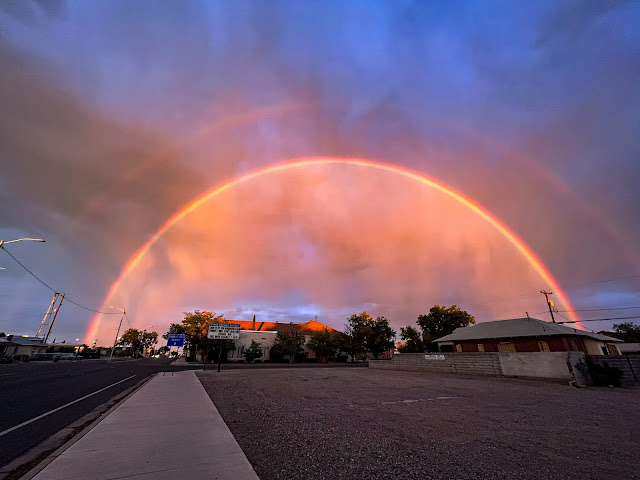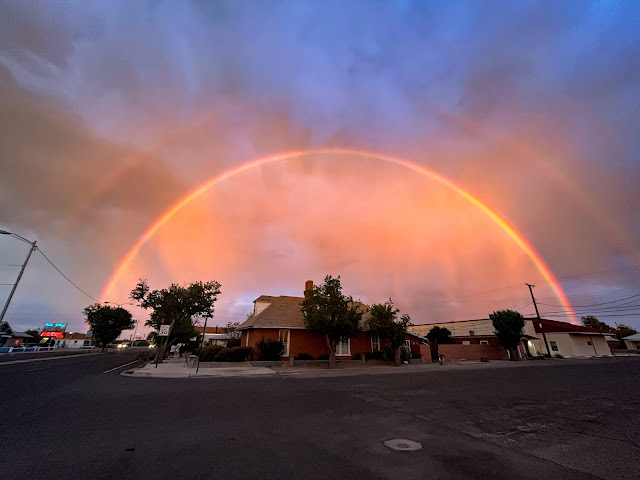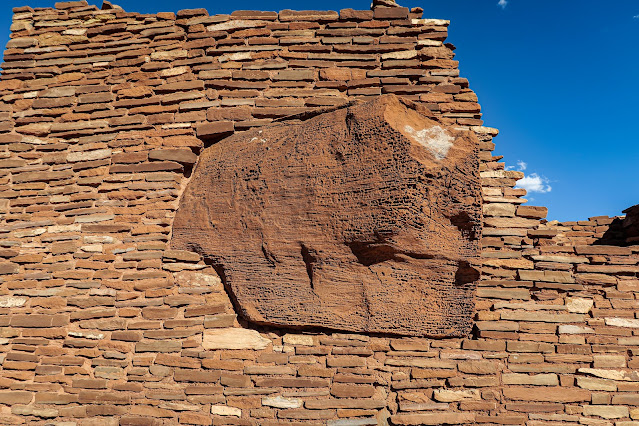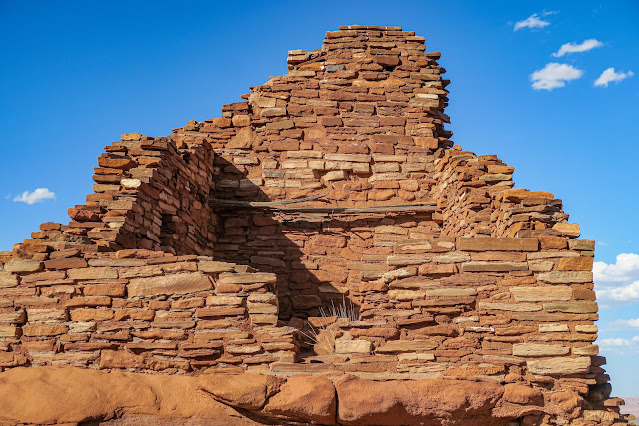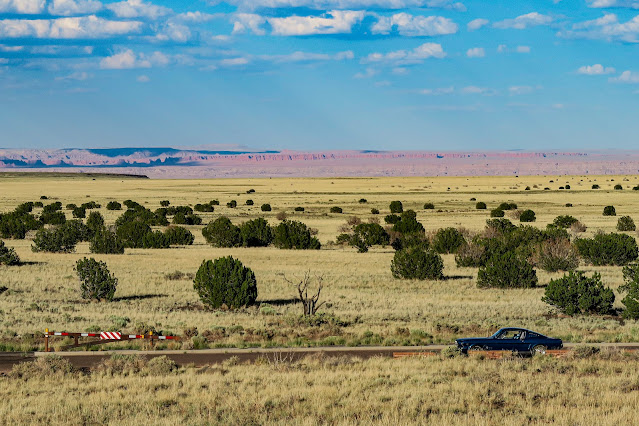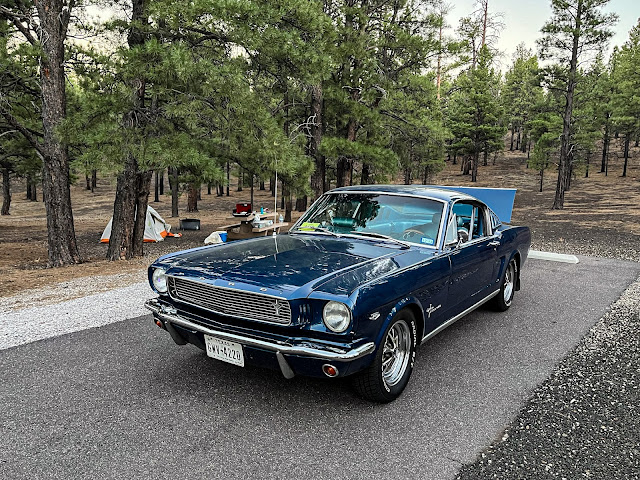8-7
----------
I zipped open my tent flaps this morning to be greeted by a
fantastic day, clear and warm and blue, the sun’s rays lancing through the ponderosas
to warm the needle-strewn ground. A perfect day for lazing about. So I did,
burying myself in a book while water for tea and oatmeal heated on the grill.
Perhaps I buried myself a little too long, considering that
I had a six-and-a-half-hour drive ahead of me. But that’s nothing to us, these
days. Jane and I, we’re born to run.
Nevertheless, I eventually did load all my gear back into
Jane so we could get a move on to the next destination: Chiricahua National Monument!
Another Arizonan park, but one in the very far southeastern corner – and one
that I’ve missed up until now, since I usually head west via the northern
Albuquerque route rather than the El Paso route.
Jane rumbled to life and I promptly remembered that I had almost no gas. No worries, I was headed back south through Flagstaff so I’d just get some gas there. And so, we set out into the sunshine.
A few miles up the road, I passed a gas station, but it was
on the left, so I continued on.
Another mile or so up the road, I passed another gas
station, again on the left, so I continued on.
Well, about a block after that, Jane’s motor very abruptly
stuttered, fizzled, and cut out, leaving me to frantically hew over towards the
shoulder. It roared back to life abruptly, stuttered some more, and then finally
hit its stride and burbled on like normal (with, of course, that same tick that
it’s had for half of the trip, now louder than ever).
I saw another gas station ahead on the left. I turned into
it as fast as I could, this time. No more left-turn snobbery from this gal.
I put a solid 14 gallons of gas into the car – the tank only
having a capacity of 16 gallons – and then pulled over to the side to pop the
hood and give her a good once-over. Could this sudden failure be gas-related?
Maybe. Or maybe it’s a failing ignition coil, or something’s loosened up, or
the tick is not as innocuous as I had supposed, or the entire engine is about
to explode. I tend to spiral like this, with these kinds of symptoms.
A few minutes later I had the valve covers off, checking for
anything suspect. No dice. The valve covers went back on, and I went through
the ignition system. No dice again. In fact, all seemed well under the hood. Ultimately
I tightened the hell out of the headers (which were quite loose, as I had
forgotten to re-tighten them after the gasket replacement two days ago), closed
the hood, and gave Jane a good heart-to-heart.
I had planned on taking a rural route through the Arizonan
mountains to Chiricahua, which would keep me out of the searing summer heat
wave that was slated to roll over the state later in the day. But suddenly,
that rural route didn’t seem like such a good idea. With no idea what’s wrong
with the car – if there’s anything wrong with the car – it’s always best to
stick to routes where towns with parts stores can be found. So, begrudgingly, I
changed my route to a much more awful one: the Phoenix route.
The Phoenix route is awful for quite a few reasons,
actually, but there were two I was really concerned about: 1, the forecasted
high temperature of 118*F for the afternoon, and 2, the massive amount of
traffic one usually encounters in town. I’ve sat in Phoenix traffic before when
it was 110*F out, and I really had no intention of doing so again. But
sometimes, you gotta do what you gotta do. It would be a good stress test for
Jane, at least, and I have people in Phoenix to rely on if things went south.
So off we went, descending from Flagstaff’s friendly climate
into the pit of hell. Every time I think of Phoenix in summer, I am reminded of
a quote from King of the Hill: “Oh my god! It’s like standing on the sun! This
city should not exist. It is a monument to man’s arrogance.” I really couldn’t
agree more.
 |
| The Descent |
 |
| But on the way, a nice hill of saguaros |
The day was sweltering, the city’s smog doing nothing to
diminish the effects of the sun. Instead, it turned into a kind of one-two
punch, the sun’s rays boring down to the earth with remarkable intensity and
the smog holding in every last bit of heat, smothering the city in an ovenlike
embrace. I could do without those two punches, thank you very much.
My arms prickled with sweat as I drew all appendages back
inside the vehicle, the breeze through the window no longer being the cooling
friendly type. My sweat soon vanished despite my best attempts to hydrate, wicked
away by the very air itself. A square of sunlight draped across one leg and
commenced roasting it until I shuffled my bandana around to cover the patch,
and I counted my blessings that I was mostly sitting in Jane’s shade. It felt
much like I’d imagine the inside of a convection oven to be.
Ahh, summer in Phoenix.
Fortunately, the dreaded traffic I had been anticipating
never materialized, and I skated through town with only a moderate amount of
roasting and a survivable case of dehydration. Count me lucky. Even luckier,
Jane was once again back to running in her prime, the morning’s drama
forgotten. Probably, it had just been the result of running bad gas too low in
the tank – usually I try to fill up every half tank, as gas stations in rural
places can have a pretty substantial water cut that makes for poor running. But
it's always better to be safe than sorry when it comes to Jane and her opinions.
With Jane happy once more, I opted to turn off at Highway 60
to head east through a more scenic route. I had some considering to do, and
considering is always best done on a nice road instead of a crappy crowded
interstate.
Well, that idea took root in my head and refused to leave,
so even with the improved scenery, I decided that I would cut Chiricahua from
this year’s trip. So instead, I settled back for a long drive towards New
Mexico. Jane hummed along unconcernedly, apparently content with my decision as
long as we had somewhere to go.
We wound our way towards the Superstition Mountains – a
range I plan on visiting next year – glorying in the smooth blacktop, the
saguaros, the rocky cliffs, and the reappearance of clouds, even if the
temperatures did still leave something to be desired.
The road narrowed, twisting between rocky spires that looked
much like fingers stretching to the sky, then plowing onwards through boulder
fields and eventually into a canyon. A massive tailings pile rose into view,
stacked so high that it towered above the canyon, a vast manmade mountain
dedicated to the pursuit of copper.
 |
| Tailings pile in the background |
 |
| Tailings "mountain" up close |
We passed the ugly – but admittedly awe-inspiring – thing and wound our
way out of the canyon and into a more peaceful, pastoral scene. Pastureland
stretched out into low foothills, which rose into humble mountains crowned by
clouds that echoed their shape. We passed farm after farm, each with their own agrarian
specialty.
Stormclouds gathered in the distance, a large diffuse block spanning
the entire sky. I was glad for the relief from the sun, but not enthused about
driving through the usual awful summer afternoon monsoons. The wind whipped up,
throwing dust into the air and veiling the landscape in a hazy brown cloud.
 |
| Difficult to tell where the dust ends and cloud begins |
The first droplets of rain skittered across Jane’s hood, and
we braced for the usual downpour. But then… it just never came. A dusting of
droplets, not even enough to raise the asphalt’s tarry scent to the surface. We
lucked out this time, considering the look of the storm.
Eventually, we pulled into the dusty small town of Deming,
New Mexico, notable only for being the only stopping point between Lordsburg
and Las Cruces, each town more than 50 miles away. But hey, it had cheap
hotels, and that seemed good enough to me. After checking Jane over to make
sure that she really was still running flawlessly after the morning’s incident
(she was), I wandered over to the local restaurant for some enchiladas. And on
the way back I saw something that put Deming on the map for me: the biggest, brightest,
most spectacular rainbow I’ve ever seen, arcing across the sky in defiance of –
or perhaps because of – the dust that swirled over the town.
I only wish that I had been outside of town to see that –
imagine the majesty of a rainbow like that sweeping across the plains and the
distant mountains. Well, I can see it in my mind, anyways.
It occurred to me that today, in my mad flight towards home,
I had the pleasure of experiencing almost every scene that the American
Southwest has to offer. From the forested remnants of volcanos, to saguaro-strewn
hills, to scrubby desertland, to bare desolate mountains, to canyons lined by
rocky spires, all bleeding together into a flickering slideshow of landscapes
scrolling over Jane’s hood. We saw the human side of it, too, the mines and the
pastures and the fields, the blisteringly hot urban city and the isolated towns
clinging to a sparse existence surrounded by miles and miles of wilderness. It’s certainly been a unique day of scenery.
It has me very excited to visit for a longer, more leisurely trip next year!
Occupied with those thoughts, I bunked down for the night
and prepared for another long day of driving tomorrow. Boy, I sure wish I could
teleport sometimes. But I guess then I would miss moments like these, places
like these, and that would be very sad.
Kelly signing out.
8-8
The Long Road Home
----------
After an uneventful night in Deming, I woke to a mostly
unremarkable day, kind of hot, kind of cloudy, not too much of anything really.
I had a truly lackluster breakfast – the type that can only be produced by a chain
hotel tenuously ensconced in a rural town – and, with nothing else to do, opted
to hit the road early.
I anticipated more of the same for the day: a lackluster, if
fast, drive across most of Texas, ending somewhere around Junction or Ozona,
depending on where I ran out of motivation. Deming is about 700 miles out from
Austin, which translates into a 10.5 hour drive, assuming you’re not stopping
for gas or food or sanity checks (I usually do try to stop for those things, to
avoid stranding myself on the roadside, or launching Jane straight off into the
desert at 85 MPH). And while I-10 is arguably the most scenic road to drive
through West Texas, a lot of times that still isn’t saying much.
So, we got to cooking.
After a short time on the road, the craggy mountains bordering
Las Cruces rose into view, a veritable thicket of imposing toothy spires
clawing upwards into the sky.
 |
| I also saw this thing... |
 |
| ...whatever it was |
“Hmm”, I said, adding the range to my list of places to
visit in the future.
I-10 dog-legged to the right, and the mountains slid by harmlessly.
We passed over the Texas border, notable only for its extremely misleading sign. Shortly thereafter, we encountered some decidedly unfriendly traffic.
 |
| Do Texans drive friendly? The entire population of Houston says NO |
I do have to say, though, that our good pal Google did
attempt to divert me off of an exit before I hit the traffic. And in my
infinite wisdom, I went, “No, silly Maps, there’s no traffic at all, surely
you’re mistaken and surely I know better! Your massive pile of data cannot
match my frankly shitty intuition!”. Anyways, so I didn’t take the exit, and
then I went over the hill and encountered the stopped traffic. Which I was then
trapped in, for over an hour, because for some gawd-awful reason that gawd-awful
city had closed every single exit for the next 10 miles. Semi trucks were
attempting to crawl over medians in desperation, only to be funneled right back
into the same single lane of traffic.
Boy, I love sitting in 0-5 MPH traffic in my ornery vintage
muscle car, which is specifically engineered to go every speed BUT 0-5 MPH.
By this point of the trip, I had progressed into the madness
of 90’/00’s Eurodance music. Really, my music taste is astonishingly bad, and
it only gets worse the more drive miles I have in a single trip. So, I listened
to some unholy repeating mix of Cascada and Corona, with a fair amount of Real
McCoy sprinkled in, for that hour. At least it was cloudy and fairly cool as
summertime goes, so I didn’t have to do a repeat of the 2017 near-heat-stroke
incident. Not that the insanity was really any less, given the music emanating
from my car.
I have to assume that Jane doesn’t mind Eurodance, or she
would have broken down on the spot.
We finally escaped El Paso, losing two hours in the process
– one to traffic, and one to the time zone change – and proceeded with the
original plan for the day: bombing down a desolate stretch of I-10 at a vaguely
frightening speed.
The landscape did periodically improve, mountains and buttes
and cliffs and scrubby hills popping up and wheeling past like scrolling
scenery in a play.
 |
| Lol. |
I always get a little excited when I start to see these
sliced roadcuts. What’s interesting about them is that they are rarely cut into
insurmountable hills. I imagine that the thought process was that if they built
the road right over the top of the hill, the wind at the top would be pretty
insane, and probably visibility would also not be great. So instead the
proverbial ‘they’ (TXDOT?) cut these little humps out of the hills, which still
yields pretty bad visibility and also acts as a unique way to focus winds into
howling wind tunnels with extremely dicey cross-winds fore and aft. However, it
does give me some nice rocks to look at, for 2-15 seconds at a time, and I do
appreciate that part.
 |
| Certainly one of the cleanest roadcuts I've ever seen! |
I did this for about five and a half hours (400 miles), at which point I reached Sonora, one town past Ozona and one town before Junction. Running a vintage hot rod at these speeds, while certainly doable (let’s be real, I’ve been doing it for a decade, and others have been doing it far longer than I), is more than a bit punishing on your body. That jazzed-up 289, bellowing into the performance-not-comfort-oriented headers at 3500 RPM, puts out more than a little noise. That ever-present roar multiplies with the whipping wind (because of course the window is open) in a fairly deafening way. What’s more, it produces a lot of heat in the process, which can and will seep into the cabin given enough time and persistence. Add in the constant vibrations of a tiny angry car howling down a rough road, and, well… you’ll never feel more alive. Or possibly, like an imminently highly polished rock in one of those vibrating lapidary machines.
By this point I had played many of the same albums and playlists on repeat, far too many times. At some point I ended up swapping from my Eurodance to a heavy rock (but not quite metal) band, and accidentally listened to them on repeat for so long that I later received a notification from Spotify that I had reached the top 0.5% of listeners of that band. So, we can say that maybe my mental state was not in much better shape than my physical state. I decided that probably I should stop for dinner and go prospecting for a hotel.
The Pit Stop BBQ accommodated my needs nicely, serving up a
big platter of sliced moist brisket with a softball-sized dollop of both potato
salad and creamed corn. Texas toast on the side, of course, plus a root beer to
polish it off. While I slowly chowed through my dish, I perused my phone for a
list of hotels in the area.
But the further I got through my meal, and the more reviews I
read about bedbugs here, or kind of stabby looking people there… well, the more
appealing home sounded to me. At this point it was just over 200 miles away,
which I’m sure seems like quite a lot to many people, but to a Texan sounds
very close indeed. Especially when one’s driving a real quick, real mean little
half-century-old Mustang. And especially as the sun is setting, removing the
desire to stay out of the burning sun from the equation.
So, with both of our tanks topped back off – me with a pile
of meat and (dubious) vegetables, Jane with good ole-fashioned hydrocarbons –
we got back on the road in high spirits and set our sights further east towards
home. Gone was the fatigue, the grunginess, the ache in a shoulder from an arm
hung out the window too long. Gone was the vague buzzing that so commonly
spreads through my muscles and inner ear, transmitted from Jane to I through
some bizarre harmonic resonance. Gone was the feeling of general wear and tear
on my body. Gone was the Eurodance. All that was left was Jane’s pilot, and
Jane’s pilot was feeling great.
We fled the sun into the ever-approaching night, abandoning
the main highway for a more pleasant Hill Country two-lane blacktop. Other cars
were few and far between, so I mostly concerned myself with keeping an eye out
for wayward deer. The sun slid behind the horizon behind us, outpaced. Placid
lavender dusk gave way to cobalt nightfall, then the inky blackness of true
night. Jane’s headlights cut bright bold paths through the darkness, the stark
contrast transporting us into a grayscale noir world.
 |
| Boy, these roads are phenomenal to cruise! |
Gradually, that blackness lifted, the lights of Austin a distant but strengthening glow. The city does sleep, sometimes – but it’s usually up late, just like me. It beckoned, calling us back to the comforts of home, the myriad firefly lights and the bustle of people all living their lives and the familiar traffic patterns and the smoke of the taco trucks and the drifting notes of hundreds of songs rising through the air from backyards and cars and bars. In short order, we joined the traffic, adding our own music to the crescendo of the city, and gladly so. Another twenty minutes, and we were puttering down our own darkened quiet street, trying (probably unsuccessfully) not to wake the neighbors. And then we were home. Another trip in the books, another chapter closed, another few thousand miles racked up on the odometer. A momentous moment, and at the same time just another point in another day. Funny, how these kinds of things can become so routine.
It's good to be back home. But then again, as long as I've got Jane somewhere nearby, I always seem to be home.
Until next time…
Kelly signing out.














